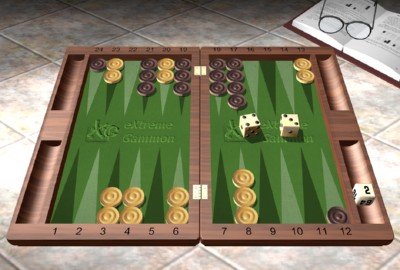Cash game. White owns the cube. White on move.

White to play 4-3.
This isn’t a particularly hard position when presented as a problem. The right play is 8/5 13/9, keeping both back points, slotting the 5-point, and playing 13/9 so as to create two cover numbers for the 5-point.
Over the board, with no one hinting that this is actually an interesting position, it’s fairly easy to make a small mistake. I’d expect to see a lot of players move either 13/9 13/10, a slight error because it doesn’t start the 5-point, or 8/4 8/5, another slight error because the builder on the 4-point is somewhat misplaced and White has fewer cover numbers for the 5-point than he should.
Leaving a blot on the midpoint after 13/9 8/5 is not especially costly because for the most part Black doesn’t want to hit it. Let’s take a quick look at how Black should play his aces after White plays 13/9 8/5.
Black needs to notice these features of the position:
> If he can play safe and not hit, he should do so. Not hitting leaves White’s timing in jeopardy, while hitting improves White’s timing somewhat and may give White a shot at Black’s blot on his ace-point. Right now White trails by 65 pips in the race, which is enough to give him some reasonable winning chances, but not enough to say that he has a well-timed back game. One extra checker back, especially if White could dance for a turn, would make a big difference.
> Playing safe is essential for Black, so if he can only play safe by hitting, he will do so. Black very much doesn’t want to get hit right now, because White’s board is already strong enough to cause real trouble.
> If Black can’t play safe, hitting wins more gammons, and may decrease the count of hit and cover numbers.
So with 6-1, 5-1, and 4-1, the best plays are 13/6, 13/7, and 13/8, all without hitting.
With 3-1, Black can only play safe by hitting, so the right play is 13/12* 4/1.
With 2-1, Black can’t be safe no matter how he plays, so he should hit. Hitting substantially increases his gammon chances compared to the non-hit play (13/11/10), while his losing chances are close after both plays.
As a last point, note that White shouldn’t consider playing 23/16 with his 4-3. While it’s true that his back game/holding game isn’t ideal, it’s the only game he has. Playing 23/16 breaks much of the contact and leaves him 58 pips behind in a game that will mostly become a 5-point holding game, an essentially hopeless situation. If White really wanted to break one of his anchors, the better choice is to keep the back anchor and play 20/13.





